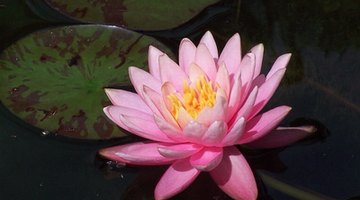The History of Water Lilies
Table of Contents
The water lily is a plant that grows in ponds and streams. The water lily has been grown for centuries, and has been a part of religious beliefs and legends. Many hybrids have been grown, and they are often seen in home ponds as well as growing wild in many parts of the world.

Identification
The water lily comes from the family Nymphaeacaea. It comes from the Greek for "nymph." In Greek legends, nymphs were protectors of springs and rivers. It is a fitting name since the water lily thrives in ponds and streams. The roots dig deep into the ground beneath the water, while the leaves float on the surface. The leaves are called lily pads, and the flower of the water lily will rest on the lily pad or even rise inches above it out of the water. The flower of the water lily has numerous petals that fan out and can be found in many colors. There are over 70 species of water lily.
Egypt and the Blue Water Lily
The water lily is native to Egypt, and is very significant in their religion and history. The Nymphaea caerulea, or the blue water lily, is where the very creation of the gods began, according to legend. In the beginning, there was only chaos. The blue water lily emerged from the darkness. When it bloomed, sitting within the petals was a god. The child was the sun god Nefertem, who began all life.
Hybrids
The first water lily found its way to England in the early 1800s, where it was grown and flourished in many noblemen's ponds and gardens. The first hybrid came into existence by accident in a glass house owned by the Duke of Devonshire. His gardener, Joseph Paxton, "discovered" the hybrid named Nymphaea devoniensis, which turned out to be a self-pollination of the Nymphaea rubra, or the red water lily. It was Paxton's caretaker, Eduard Ortgies, who created the first real water lily hybrid. It was called the Nymphaea ortgiesiano-rubra.
The first hybrids in the United States were developed by Edmund Sturtevant in 1876.
Monet
Claude Monet, the French painter, is most well known for his artwork of his water lilies. Monet had a residence in Giverny, France, where he had a water lily pond and a Japanese bridge built. Monet painted several scenes of the bridge and nearly 250 paintings of the the water lilies. Some of them can be seen in museums, while others belong to private collectors.
Misconceptions
Many people believe that the water lily and the lotus flower are one and the same. This is not true. While the Egyptian blue water lily is called a lotus, it is really a member of the water lily family. The lotus flower is in the Nelumbo family, and it is native to India where it is the national flower. The difference between the water lily and lotus can be determined by the leaves. The leaves of the water lily rest on the water, while the leaves of the lotus flower are above the water.
References
Writer Bio
Marilla Mulwane has been writing professionally since 2005. She has published a fantasy novel for young adults and writes articles on literature, pets, video games and tattoos. Her poetry has been featured on the website and products for the nonprofit organization HALos. She graduated from the State University of New York, Oneonta with a Bachelor of Arts in English and creative writing.
Photo Credits
- Pink waterlily image by teebo from Fotolia.com
- Pink waterlily image by teebo from Fotolia.com
More Articles



